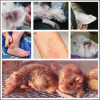Outstanding animal studies in allergy II. From atopic barrier and microbiome to allergen-specific immunotherapy
- PMID: 28375932
- PMCID: PMC5424576
- DOI: 10.1097/ACI.0000000000000364
Outstanding animal studies in allergy II. From atopic barrier and microbiome to allergen-specific immunotherapy
Abstract
Purpose of review: Animal studies published within the past 18 months were assessed, focusing on innate and specific immunomodulation, providing knowledge of high translational relevance for human atopic and allergic diseases.
Recent findings: Allergic companion animals represent alternative models, but most studies were done in mice. Atopic dermatitis mouse models were refined by the utilization of cytokines like IL-23 and relevant skin allergens or enzymes. A novel IL-6 reporter mouse allows biomonitoring of inflammation. Both skin pH and the (transferable) microflora have a pivotal role in modulating the skin barrier. The microflora of the gastrointestinal mucosa maintains tolerance to dietary compounds and can be disturbed by antiacid drugs. A key mouse study evidenced that dust from Amish households, but not from Hutterites protected mice against asthma. In studies on subcutaneous and sublingual allergen-specific immunotherapy, much focus was given on delivery and adjuvants, using poly-lacto-co-glycolic particles, CpGs, probiotics or Vitamin D3. The epicutaneous and intralymphatic routes showed promising results in mice and horses in terms of prophylactic and therapeutic allergy treatment.
Summary: In atopic dermatitis, food allergies and asthma, environmental factors, together with the resident microflora and barrier status, decide on sensitization versus tolerance. Also allergen-specific immunotherapy operates with immunomodulatory principles.
Figures


Similar articles
-
Epithelial barrier dysfunctions in atopic dermatitis: a skin-gut-lung model linking microbiome alteration and immune dysregulation.Br J Dermatol. 2018 Sep;179(3):570-581. doi: 10.1111/bjd.16734. Epub 2018 Jul 11. Br J Dermatol. 2018. PMID: 29761483 Review.
-
The riddle of response to cutaneous allergen exposure in patients with atopic dermatitis.Ann Allergy Asthma Immunol. 2024 Sep;133(3):244-251. doi: 10.1016/j.anai.2024.05.005. Epub 2024 May 11. Ann Allergy Asthma Immunol. 2024. PMID: 38740132 Review.
-
Mechanisms for initiation of food allergy by skin pre-disposed to atopic dermatitis.Immunol Rev. 2024 Sep;326(1):151-161. doi: 10.1111/imr.13367. Epub 2024 Jul 15. Immunol Rev. 2024. PMID: 39007725 Review.
-
International consensus on allergy immunotherapy.J Allergy Clin Immunol. 2015 Sep;136(3):556-68. doi: 10.1016/j.jaci.2015.04.047. Epub 2015 Jul 7. J Allergy Clin Immunol. 2015. PMID: 26162571 Review.
-
Skin as a novel route for allergen-specific immunotherapy.Curr Pharm Des. 2014;20(6):886-91. doi: 10.2174/13816128113199990051. Curr Pharm Des. 2014. PMID: 23701565
Cited by
-
Role of the Microbiome in Allergic Disease Development.Curr Allergy Asthma Rep. 2020 Jun 16;20(9):44. doi: 10.1007/s11882-020-00944-2. Curr Allergy Asthma Rep. 2020. PMID: 32548788 Free PMC article. Review.
-
Clinical efficacy of sublingual immunotherapy is associated with restoration of steady-state serum lipocalin 2 after SLIT: a pilot study.World Allergy Organ J. 2018 Oct 1;11(1):21. doi: 10.1186/s40413-018-0201-8. eCollection 2018. World Allergy Organ J. 2018. PMID: 30323863 Free PMC article.
-
Microcrystalline Tyrosine and Aluminum as Adjuvants in Allergen-Specific Immunotherapy Protect from IgE-Mediated Reactivity in Mouse Models and Act Independently of Inflammasome and TLR Signaling.J Immunol. 2018 May 1;200(9):3151-3159. doi: 10.4049/jimmunol.1800035. Epub 2018 Mar 28. J Immunol. 2018. PMID: 29592962 Free PMC article.
-
Contributions of innate lymphocytes to allergic responses.Curr Opin Allergy Clin Immunol. 2019 Apr;19(2):175-184. doi: 10.1097/ACI.0000000000000515. Curr Opin Allergy Clin Immunol. 2019. PMID: 30672750 Free PMC article. Review.
-
Inhibition of pathologic immunoglobulin E in food allergy by EBF-2 and active compound berberine associated with immunometabolism regulation.Front Immunol. 2023 Feb 7;14:1081121. doi: 10.3389/fimmu.2023.1081121. eCollection 2023. Front Immunol. 2023. PMID: 36825019 Free PMC article.
References
-
- Shamji M, Kappen J, Akdis M, et al. Biomarkers for monitoring clinical efficacy of allergen immunotherapy for allergic rhinoconjunctivitis and allergic asthma: an EAACI Position Paper. Allergy 2017; [Epub ahead of print]. - PubMed
-
- Grimm H, Huth M. Jensen-Jarolim E. One health: many patients? A short theory on what makes an animal a patient. In Comparative medicine: diseases linking humans with their animals. Switzerland:Springer International Publishing; 2017. 219–230.
-
- Jensen-Jarolim E, Herrmann I, Panakova L, Janda J. Jensen-Jarolim E. Allergic and atopic eczema in humans and their animals. In Comparative medicine: diseases linking humans with their animals. Switzerland:Springer International Publishing; 2017. 131–150.
-
- Berker M, Frank LJ, Gessner AL, et al. Allergies: a T cells perspective in the era beyond the TH1/TH2 paradigm. Clin Immunol 2017; 174:73–83. - PubMed
Publication types
MeSH terms
Substances
LinkOut - more resources
Full Text Sources
Other Literature Sources
Medical
Research Materials
Miscellaneous

